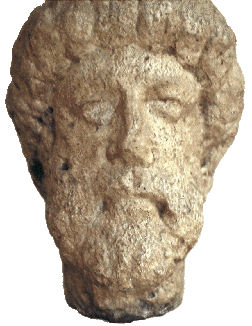|
by Barbara F. Abendschein .
Soon after the Roman conquest of Pannonia in 12 BC, Carnuntum (near Vienna,
Austria) became a base for military operations led by Tiberius against the
Marcomanni, a Germanic tribal confederacy. By 14 AD, the area was patrolled
by the legio XV Apollinaris, transferred from Emona, the first Pannonian
town on the Amber Road. At this time, for military and administrative reasons,
the eastern part of Noricum province, to which Carnuntum originally belonged,
was transferred to the province of Pannonia.
Between AD 35 and 40, legio XV erected a military camp which initated the
Roman settlement in Carnuntum, and became one of the largest and most important
fortresses on the Danube limes or fortified boundary. In AD 62 the
legion was dispatched to the eastern campaigns, returning in 71 and remaining
until the latter part of the reign of Trajan (AD 98-117) when it was replaced
by legio XIV Gemina, which remained garrisoned in Carnuntum for the rest
of the Roman era.
When Trajan divided the province of Pannonia into two parts, Carnuntum became
the capital or governor's seat of Pannonia Superior. The next emperor, Hadrian,
visited in AD 124 and granted Carnuntum the rights of an official town or
municipium. After the Viennese basin was overrun by
Barbarian tribes from
north of the Danube including the Marcomanni and Quadi, Marcus Aurelius (fig.1)
launched a counteroffensive from his headquarters at Carnuntum, where from
AD 172 to 174 he also wrote the second book of his Meditations, a
literary/philosophical treatise on Stoic values which has stood the test
of time. On April 9, 193 Septimius Serverus was pronounced emperor while
in Carnuntum, and awarded the city the status of colonia.
The site:
Like many Danubian towns, Carnuntum has three basic elements: the military
camp; its attached settlement or canabae; and the civilian municipium. Surrounded
by the canabae, the legionary camp sat on a ridge overlooking the Danube
to the north. To the southwest are the Governor's palace, and remains of
a forum. Of the original camp built in AD 35-40 by the legio XV Apollinaris,
only the foundation of the south tower gate has been excavated. M ost the
the camp's buried remains date from the 2nd and 3rd centuries AD. ost the
the camp's buried remains date from the 2nd and 3rd centuries AD.
Baths in the legionary town included an apodyterium or changing room, cold
room (frigidarium), warm room (tepidarium), hot room
(caldarium), and sweatbaths (sudatorium), the latter two with
subground heating or hypocausts. Nearby was a small swimming pool
(piscina) and open exercise courtyard. The baths, with separate facilities
for men and women, were administered by two civil servants.
Fig 1: Statue of the Roman emperor Marcus Aurelius at Carnuntum
Museum (©1999 BFA Documentary Photography).
Between the canabae and municipium is an ancient burial route with examples
of tombstones that once lined the roads between towns. Burial within towns
was forbidden by the Roman Law of the 12 Tables.The municipium or civilian
town of Carnuntum lies beneath and west of modern Petronell. Adherence to
Roman standards of heating, plumbing, mosaics and window glass varied from
house to house depending on the wealth of the owner. Building codes specifying
height and fire regulations were enforced by the city administration. Private
houses often contained workrooms as well as living quarters. .Outside the
fenced area, one can see rectangular blocks of various sized building foundations
with interconnecting courtyards, narrow streets and fireproof walls separating
neighbors.
Townhouses reveal living quarters, retail establishments and workshops next
to one another and under the same roof. Latrines were found near the public
baths. Two water trenches were provided to remove sewage and in front of
the benches to facilitate washing. With up to 20 holes and no partitions,
these facilities also served to provide tanners with urine for leather treatment
processes, a commodity taxed by Vespasian (AD 69-79). About 500 m to the
south is the municipal amphitheater, an irregular ellipse measuring 130 x
110 meters with an inner arena of 68 x 50 meters. Presumably built under
Hadrian, it hosted gladiator fights and other public spectacles, and seated
13,000.
Carnuntum's location on the limes is marked by foundation stones showing
the empire's defended boundary line just east of the civilian town. Here
a collection of reliefs, gravestones and mosaics lie in a fenced field;
additional stonework and inscriptions may be seen in the on-site lapidary
museum. Shrines include a Mithraeum, now in the site Museum (in the canabae),and
a recently reconstructed temple to the goddess Diana, unique in Austria.
Farms and agricultural estates just outside the city included the recently
discovered villa rustica of an agricultural estate. Unheated rooms included
the crafts workshop, provisions room, storage for machinery and a blacksmith's
forge. Sitting in a farmer's field, the cleanly restored archaeological site
at Hoeflein, now unearthed after some 1600 years of invisibility, has, somewhat
ironically, the most modern appearance in this pastoral scene.
References:
This article appears in Vol.2, No.3 of Athena
Review.
.
|
|